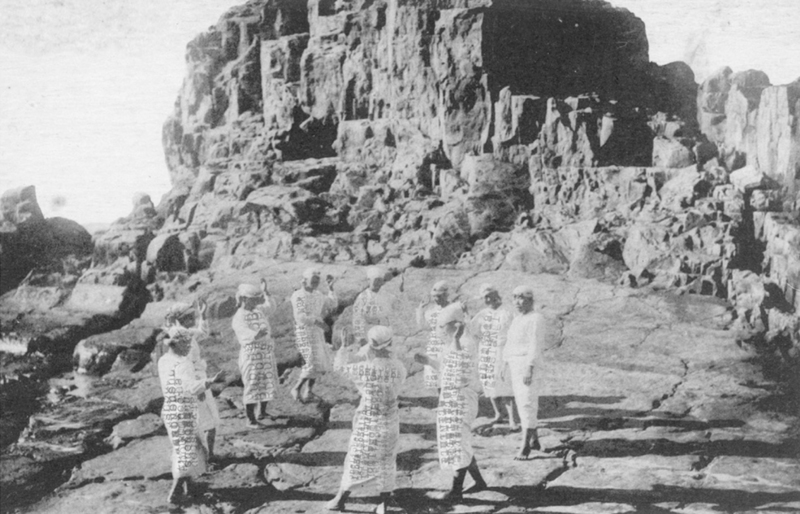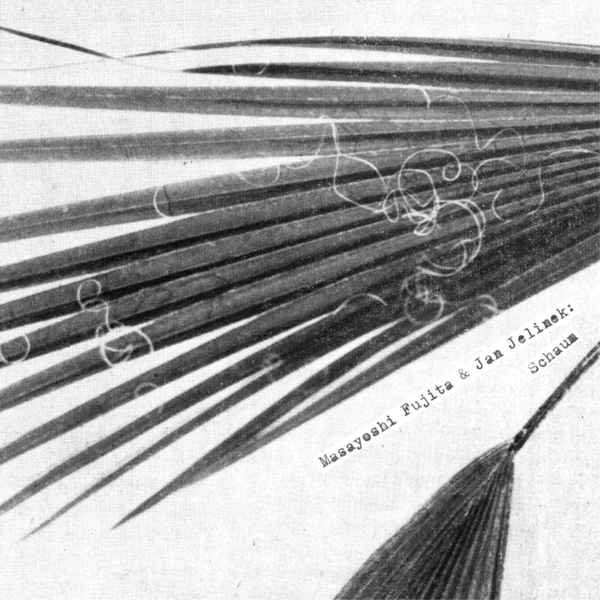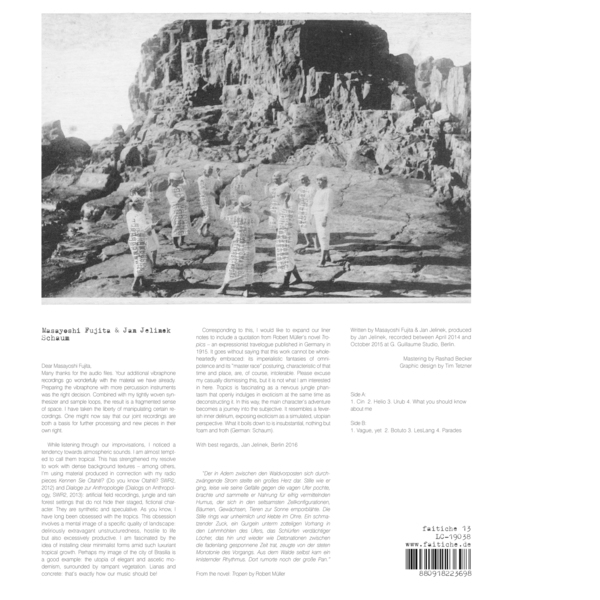Masayoshi Fujita & Jan Jelinek:
Schaum
A1. Cin (05:33)
A2. Helio (05:24)
A3. Urub (04:27)
A4. What you should know about me (03:48)
B1. Vague, yet (04:14)
B2. Botuto (05:13)
B3. LesLang (04:23)
B4. Parades (09:33)
Masayoshi Fujita & Jan Jelinek:
Schaum
Faitiche is very pleased to announce the release of a new album by Masayoshi Fujita & Jan Jelinek. Since their debut (Bird, Lake, Objects, faitiche03, 2010) they have played improvised concerts around the world. Japanese vibraphonist Masayoshi Fujita prepares his instrument with various percussion elements as well as metal objects and toys, while Jan Jelinek layers loops made using small-scale electronic devices. Schaum (German for froth, foam) is the duo’s second album.
"Der in Adern zwischen den Waldvorposten sich durchzwängende Strom stellte ein großes Herz dar. Stille wie er ging, leise wie seine Gefälle gegen die vagen Ufer pochte, brachte und sammelte er Nahrung für eifrig vermittelnden Humus, der sich in den seltsamsten Zellkonfigurationen, Bäumen, Gewächsen, Tieren zur Sonne emporblähte. Die Stille rings war unheimlich und klebte im Ohre. Ein schmatzender Zuck, ein Gurgeln unterm zotteligen Vorhang in den Lehmhöhlen des Ufers, das Schlürfen verdächtiger Löcher, das hin und wieder wie Detonationen zwischen die fadenlang gesponnene Zeit trat, zeugte von der steten Monotonie des Vorgangs. Aus dem Walde selbst kam ein knisternder Rhythmus. Dort rumorte noch dergroße Pan."
from the novel Tropen by Robert Müller

Dear Masayoshi Fujita,
Many thanks for the audio files. Your additional vibraphone recordings go wonderfully with the material we have already. Preparing the vibraphone with more percussion instruments was the right decision. Combined with my tightly woven synthesizer and sample loops, the result is a fragmented sense of space. I have taken the liberty of manipulating certain recordings. One might now say that our joint recordings are both a basis for further processing and new pieces in their own right.
While listening through our improvisations, I noticed a tendency towards atmospheric sounds. I am almost tempted to call them tropical. This has strengthened my resolve to work with dense background textures – among others, I’m using material produced in connection with my radio pieces Kennen Sie Otahiti? (Do you know Otahiti? SWR2, 2012) and Dialoge zur Anthropologie (Dialogs on Anthropology, SWR2, 2013): artificial field recordings, jungle and rain forest settings that do not hide their staged, fictional character. They are synthetic and speculative. As you know, I have long been obsessed with the tropics. This obsession involves a mental image of a specific quality of landscape: deliriously extravagant unstructuredness, hostile to life but also excessively productive. I am fascinated by the idea of installing clear minimalist forms amid such luxuriant tropical growth. Perhaps my image of the city of Brasilia is a good example: the utopia of elegant and ascetic modernism, surrounded by rampant vegetation.
Corresponding to this, I would like to expand our liner notes to include a quotation from Robert Müller’s novel Tropics – an expressionist travelogue published in Germany in 1915. It goes without saying that this work cannot be wholeheartedly embraced: its imperialistic fantasies of omnipotence and its “master race” posturing, characteristic of that time and place, are, of course, intolerable. Please excuse my casually dismissing this, but it is not what I am interested in here. Tropics is fascinating as a nervous jungle phantasm that openly indulges in exoticism at the same time as deconstructing it. In this way, the main character’s adventure becomes a journey into the subjective. It resembles a feverish inner delirium, exposing exoticism as a simulated, utopian perspective. What it boils down to is insubstantial, nothing but foam and froth.
With best regards, Jan Jelinek, Berlin 2016

LP with photos, text and images on the sleeve (inside/out), special CD packaging (Herzog-Idex Smartpac, inside/out) including a booklet (4 pages) with photos and text.
Written by Masayoshi Fujita & Jan Jelinek, produced by Jan Jelinek, recorded between April 2014 and October 2015 at G. Guillaume Studio, Berlin. Mastering by Rashad Becker. Graphic design by Tim Tetzner. Copyright control.


